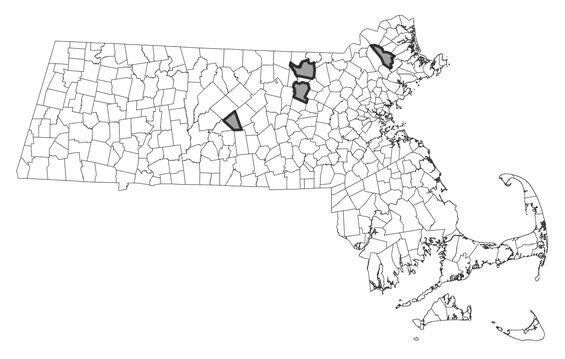- Scientific name: Sparganium natans
- Species of Greatest Conservation Need (MA State Wildlife Action Plan)
Endangered (MA Endangered Species Act)
Description
The bur-reeds (genus Sparganium) are a small group of grass-like aquatic and wetland plants of the cat-tail family (Typhaceae); seven species are known from Massachusetts. Unlike true grasses, the leaves lack sheaths and ligules (a characteristic flap of tissue at the base of the leaf blades), and unlike many other aquatic and wetland species with ribbon-like leaves, the leaves of bur-reeds lack a defined mid-vein. Male and female flowers are borne in separate flower heads. Fruits are arranged in dense spherical heads. The leaves of small bur-reed are 2-6 mm (0.1-0.2 in) wide and are usually limp and found floating on the surface of the water. Occasionally, plants growing near shore or those that have been stranded by falling water levels become stiff and have an upright growth form. In very deep water, the leaves never reach the surface and grow up to about 0.6 m (2 ft) long. The weak, unbranched flowering stalks typically float on the water surface but will become upright on stranded plants.
Small bur-reed is distinguished from all other bur-reed species by having a single, terminal head of male flowers―all other species have more than one male flower head. One to three spherical fruiting heads are located along the sides of the flower stalk below the male head. These are 5-12 mm (0.2-0.5 in) in diameter when mature. The individual fruits are 2-4 mm (0.1-0.2 in) long, hard, green or brownish, and have an elliptic body that tapers at the top into curved beak. Plants are typically found growing in large clonal patches, sometimes covering extensive areas
The seven Massachusetts bur-reed species can only be confidently distinguished from one another when they are fertile. Small bur-reed has narrower leaves than some common species and a stronger tendency to grow in deep water with an aquatic growth form than many, but neither vegetative nor growth form characteristics is diagnostic. Unfortunately, small bur-reed populations in Massachusetts flower erratically and often sparsely. In some years, flowers may not be found at all, and in others only a small percentage of plants are fertile. Furthermore, the characteristic single, terminal, male flower heads are short-lived and disintegrate shortly after shedding their pollen (though the stalks of male flower heads often remain attached to the stems long after the flowers have shed, allowing one to count the number of heads that were originally present). Flowers are most often observed between mid-June and mid-July but may be found as late as September.
Life cycle and behavior

Population status
Small bur-reed is listed under the Massachusetts Endangered Species Act as endangered. All listed species are protected from killing, collecting, possessing, or sale and from activities that would destroy habitat and thus directly or indirectly cause mortality or disrupt critical behaviors.
Massachusetts Natural Heritage & Endangered Species Program database has 11 records from 4 counties: Berkshire, Essex, Middlesex, and Worcester. Four of those records are within the last 25-year period.
Distribution and abundance
Small bur-reed has a range that circles the globe at high latitudes (excepting Greenland). In North America, it grows from Newfoundland west to Alaska. In the East, its range extends south to New Jersey and northern Pennsylvania. In the central United States, it is limited to the Great Lakes states. In the West, its range extends south to Arizona, Utah, and California.

Habitat
Small bur-reed grows in shallow water along pond shores, flooded meander scars on floodplains, and in smaller pools in peatlands. It most often grows on soft, muddy substrates. Ponds with small bur-reed populations often have dense aquatic vegetation and indicators of eutrophic (nutrient-rich) waters such as coontail (Ceratophyllum demersum) and duckweed species (family Araceae). Additional associates may include pondweeds (Potamogeton spp.), water-shield (Brassenia schreberi), tape-grass (Vallisneria americana), water willow (Decodon verticillatus), and bladderworts (Utricularia spp.).
Healthy habitats are vital for supporting native wildlife and plants. Explore habitats and learn about conservation and restoration in Massachusetts.
Threats
About a third of the extant populations are in ponds with invasive species (fanwort, Cabomba caroliniana, and variablemilfoil, Myriophyllum heterophyllum). The effect of competition from introduced species is unknown but should be monitored. In addition, where these and other exotic aquatic invasives are present, there is sometimes the desire to control them with herbicides; control of aquatic vegetation using herbicides, if not done carefully, could pose a serious threat to small bur-reed.
Conservation
All active management of rare plant populations (including invasive species control) is subject to review under the Massachusetts Endangered Species Act and should be planned in close consultation with MassWildlife’s Natural Heritage & Endangered Species Program.
References
Crow, G.E., and C.B. Hellquist. 1985. Aquatic Vascular Plants of New England: Part 2. Typhaceae and Sparganiaceae. New Hampshire Agricultural Experiment Station Bulletin 517.
Kraul, R.B. 2000. Sparganium. Pages 270–277 in Flora of North America Editorial Committee (Editors). Flora of North America North of Mexico. Volume 22: Magnoliophyta: Alismatidae, Arecidae, Commelinidae (in part), and Zingiberidae. Oxford University Press, New York, New York, USA.
Contact
| Date published: | May 8, 2025 |
|---|